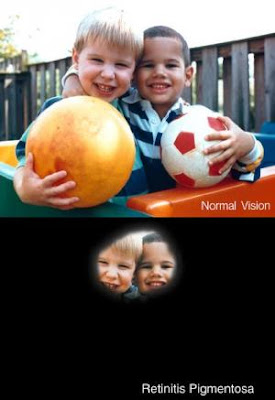Toward Making the Blind See: Gene Therapy Restores Vision in Mice
Scientists from Buffalo, Cleveland, and Oklahoma City made a huge step toward making the blind see, and they did it by using a form of gene therapy that does not involve the use of modified viruses. In a research report published in the April 2010 print issue of The FASEB Journal, scientists describe how they used a non-viral, synthetic nanoparticle carrier to improve and save the sight of mice with retinitis pigmentosa, an inherited disease characterized by progressive vision loss and eventual blindness.
 |
| Top: Normal vision. Bottom: The same scene as it might be viewed by a person with retinitis pigmentosa. (Credit: National Eye Institute, National Institutes of Health) |
To make this discovery, Naash and colleagues used groups of mice with the retinal degeneration slow (Rds) gene, which causes retinitis pigmentosa. The mice received one of three types of "treatments:" nanoparticles containing the normal copy of the Rds gene, the normal gene alone, or saline solution. After these treatments were delivered to the mice, the structure and function of the retina were analyzed by comparing them to untreated mice with retinitis pigmentosa and healthy mice with the normal Rds gene. Researchers also measured the level and pattern of Rds gene expression, as well as functional, structural and biochemical improvements in disease symptoms. They discovered that mice receiving the nanoparticle gene therapy show significant signs of healing. These mice had structural improvement in their retinas, as well as functional vision improvements, which lasted throughout the duration of the study. The mice that received the gene alone or saline continued to lose their vision. The nanoparticles were safe and well-tolerated with no adverse effects.
"Making the blind see was once called a miracle," said Gerald Weissmann, M.D., Editor-in-Chief of The FASEB Journal. "As we have expanded our understanding of evolution, genetics, and nanotechnology, chances are that "miraculous" cures will become as commonplace as those claimed by faith-healers past and present."
According to the National Institutes of Health Office of Rare Diseases Research, retinitis pigmentosa is a group of inherited eye diseases that affect the retina. Retinitis pigmentosa causes cells in the retina to die prematurely, eventually leading to vision loss. There is no cure.




















0 comments:
Post a Comment
Please do not spam Spam comments will be deleted immediately upon my review.